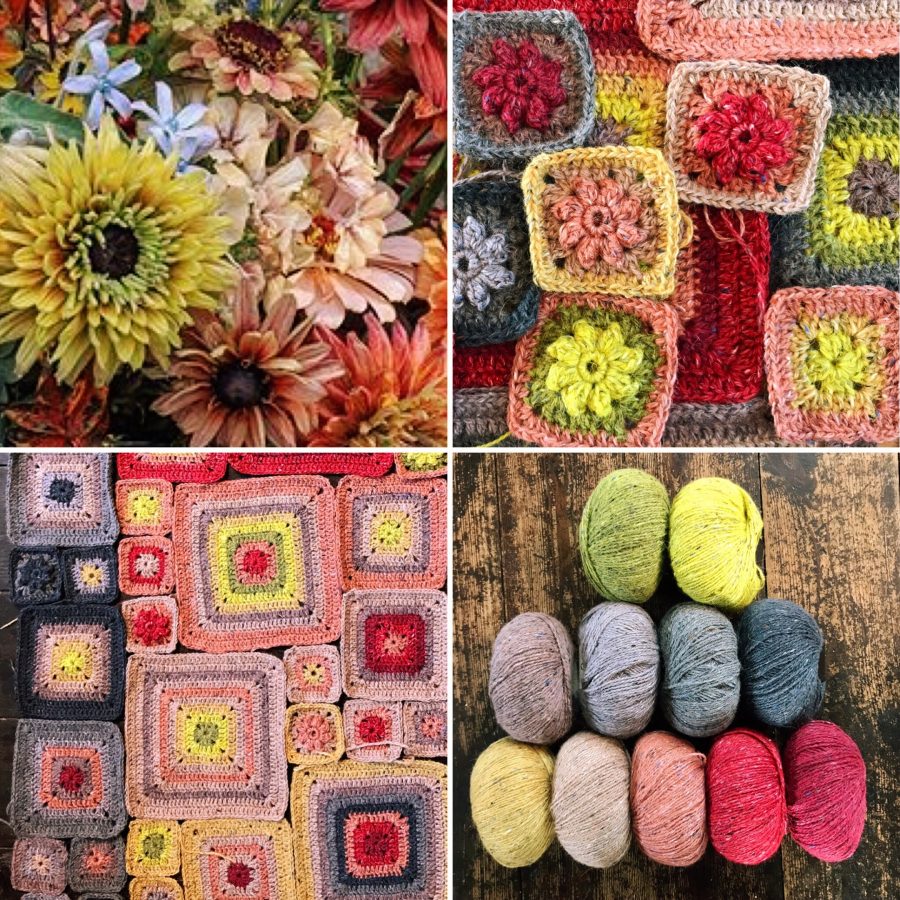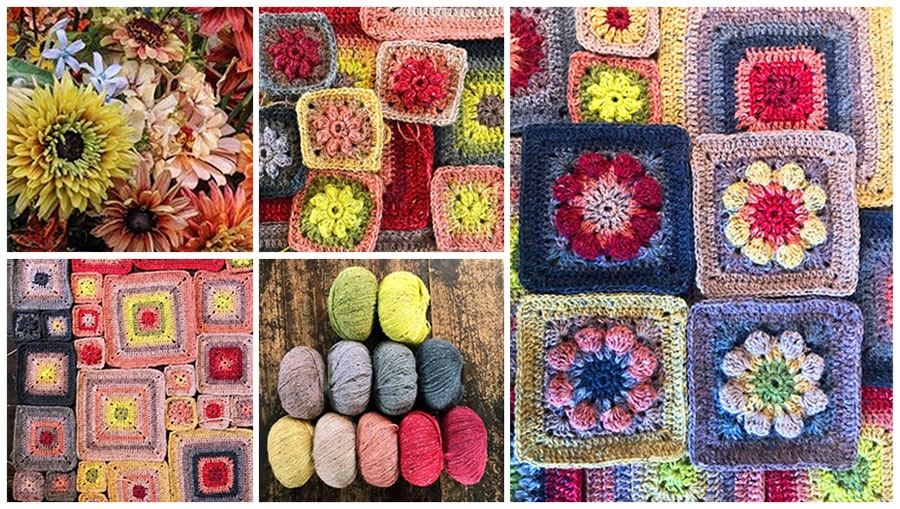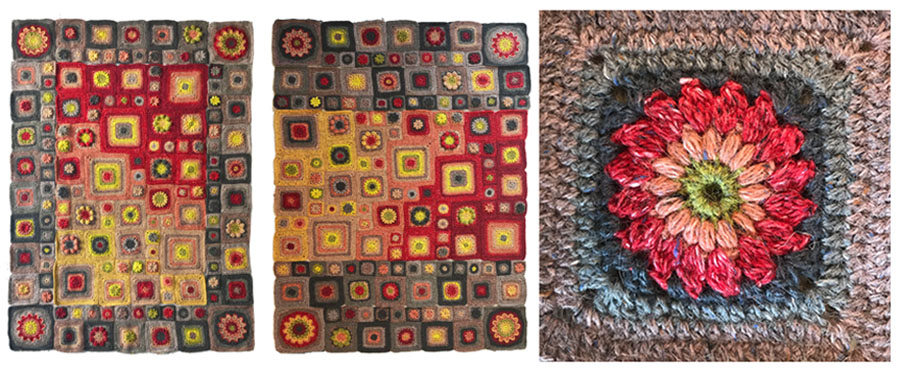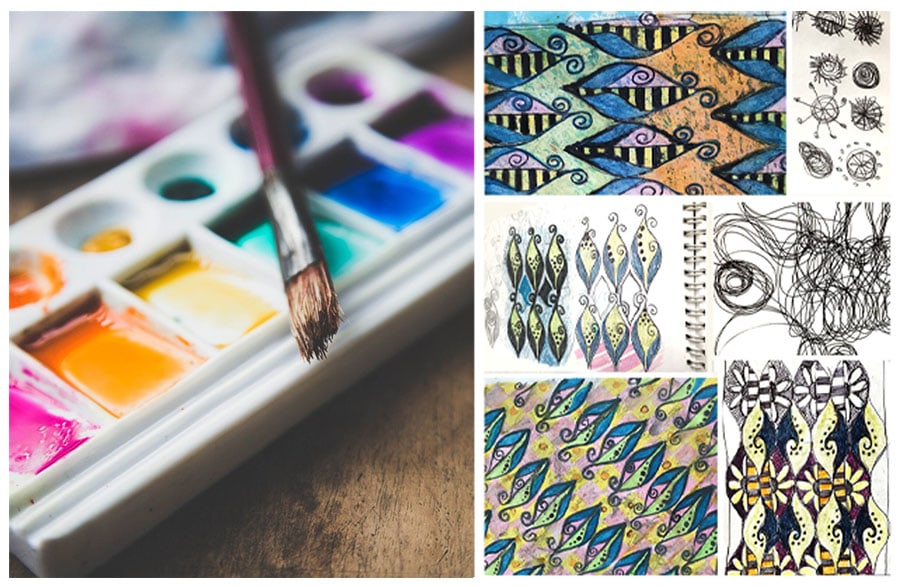If you’d rather listen to this post here’s an audio version for you……..
Do you ever find yourself avoiding a craft project that you were previously enjoying?
If the answer is yes – then this blog post is for you!
Crochet and other slow making methods allow time for thinking and experiencing the work rather than just focusing on the finish line and getting to the end. This attentive way of working can draw our attention to not just what we’re making and the techniques we’re using but also our approach to making, the reasons why we choose to make with our hands and perhaps this can help us gain insight into ourselves as well as our craft.
The thing I love most about crafting as part of a community – both in real life and online, is the conversation that takes place between makers. There are common themes that crop up regularly – one of them is THE BLOCK which I also call project paralysis and this can strike at any time.
You’ll know when you’ve hit this block because you won’t want to look at your work and you can’t think about it without feeling a bit guilty. The project just sits there annoying you – half done, nearly finished or barely started.
It may even be out of sight – but it’s definitely on your mind.
It’s worth acknowledging that craft progress can stall for many reasons; lack of time, resources or finances to name a few. These are all valid and very personal reasons which may be out of your control right now and these things are not the same as THE BLOCK.
So, this is my tool kit for challenging project paralysis.
1. ACCEPTANCE
Admit you’ve hit a block in your work and accept it as part of the process. It’s normal, it’s common and it’s usually temporary, but be honest with yourself.
Don’t make up excuses, just face it. You’ve lost your crojo
2. ASK YOURSELF WHY
Why don’t you want to do the work?
Common answers include;
“I just don’t feel like it.”
“I’ve lost my motivation.”
“ I’m not enjoying it”
Or something similar.
Again, ask yourself why – why have you lost your motivation? And try to really think about this question. What is it about the project that you’re not enjoying?
Often there’ll be an underlying reason why you’ve lost some enthusiasm. It might be that you’ve made a mistake somewhere and you can’t face undoing it. Or you might be unsure about your colour choices and now you don’t like it as much as you did.
Or you may be feeling overwhelmed by how much work you still have to do.
Or perhaps someone’s been critical of your work and now you’ve lost your confidence.
Once you’ve identified the reason why you’ve stalled you’re halfway to getting back on track.
Often more general anxieties about broader issues in our lives can find their way into our craft lives
The next step is to tackle and resolve the problem. I know it’s a cliche but we do learn from our mistakes and you may have to undo the bit that’s gone wrong.
Yes, I know that’s really annoying and it feels like a total waste of time but I honestly believe that unmaking is as important as making. I do it all the time and feel an enormous sense of satisfaction once I’ve got it right,
If you’re unhappy about a colour choice there are several things I’d suggest.
- Sometimes colours can look awkward when they’re 6 inches from your nose but they take on a totally different quality when they’re just part of the mix, or when experienced in context – which means in the finished product, not a partially completed work in progress. I don’t think I’ve ever worked on a project where I haven’t, at some stage, disliked it intensely, questioned myself or just wanted to give up.
“The best way out is always through” Robert Frost
- If you’re working with individual motifs and lots of colours your finished work will be so much more than the sum of its parts, so you simply have to make a decision to accept this colour as part of the group. It may not be what you intended but the chances are that the final work will be utterly gorgeous, and that awkward colour will just be absorbed into the overall aesthetic of the work. I also genuinely believe that the most exciting work includes some awkward colour juxtapositions.
Too much harmony and co-ordination can get a little tedious.
- If you’ve really taken a dislike to an individual colour in a collection you may need to take drastic action. What colour would you replace it with? Make a decision. Keep going with this colour and accept it. Or undo your work and replace it.
Yes, you’ve wasted some time and yarn, but you’ll be wasting a whole lot more if you never finish the project.
- Try reframing the way you think about undoing and redoing. It’s not a sign of failure or ineptitude, it’s a sign that you’re serious about the quality of your work and you’re fine tuning your craft skills.
I never regret redoing something, but I always regret it if I don’t.
3) MISE EN SCENE
This French term is used in restaurants and bars and also in the film industry. It’s all about preparing your environment and making it conducive to a feeling of calm and creativity.
Opening up the curtains to let in as much light as possible, directing your lamp correctly, adjusting the room temperature, lighting a candle or incense, finding the right audio book, moisturising your hands, arranging some flowers to look at or anything different or beautiful to look at.
Setting the scene for your craft activity may feel like procrastination, and no these things won’t get the work done for you, but it all helps to set the scene so you can play your part without being heckled by the dirty dishes.
Lights, crochet, action!
4) MIS EN PLACE
This naturally follows mis en scene and ensures that everything is there in front of you and ready for use.
Sometimes if I’m finding it difficult to get started on my work I just find a little time to tidy my work space and make sure I have all the tools ready for my activity. I’ll also arrange whatever work I’m supposed to be doing seductively on my work bench and this makes it more likely that my interest will be rekindled.
It feels good to work in a tidy, organised space, I don’t do it very often but when I do I’m always more productive and it’s far more enjoyable.
Routines can help us develop habits and if you routinely organise your work tools and space you’re more likely pick up your project where you left off.
No, a beautifully organised work space won’t do the work for you, but it will FEEL so much better.
5) GIVE YOURSELF A BREAK
Don’t be too hard on yourself. Sometimes you just need a break from a project. There’s often no deadline other that the one you’ve given yourself. Tell yourself you’re having a break from the project. Take a week, an hour, two days – you decide. Have a complete break then come back to it with a clear head.
On the day you return to your project set the scene. Don’t wait until you feel like doing it. Don’t have a conversation with your alter ego, bunk off, or try to talk your way out of it – just start doing the work.
If you want to find your flow you need to be proactive- it won’t come looking for you.
6) EMBRACE THE MUNDANE
Perhaps you really enjoy starting a new project – it feels like a voyage of discovery. But once you get going all you have to look forward to is hours and hours of monotonous making.
The cold reality of every stunning craft project is that it’s the result of hours spent doing mundane repetitive actions. For many of us that’s part of the appeal. The repetitive sewing in of ends, piecing and joining; stitch after stitch of sameness – that’s the mechanics of craft and every single stitch counts. Avoid looking for short cuts, the end is often a disappointment and you can waste a lot of time trying to get back on the right track.
Repetition is never going to be the most creative part of a project but by paying attention to every single stitch and making it as perfect as you can, you can still take pleasure in the mundane and feel pride in your work.
Quietly and carefully stitching and joining your work may not invoke admiring complements but you know that this is progress and stitch by stitch you’re on your way to finishing your work.
Craft blocks often form a pattern so it’s worth looking back on other projects to see if there’s a common thread to these periods of procrastination.
Beating project paralysis is often as simple as reframing how you think about the process and taking your aim off the final product. Try changing how you deal with mistakes, restage the environment you work in, or simply remind yourself that mundane repetitive activities are just the necessary building blocks of all beautiful craft objects.
If you’re struggling with motivation, feeling uninspired, unproductive or just lacking a little sparkle in your creative life why not spend a week with me this summer on The Creativity Firestarter?
Using a range of simple, playful, tried and tested design activities I can help you build your own creative tool kit and develop an inquisitive and productive mindset.
These are skills that can be applied to any art, design or craft practice so follow your curiosity and nip over here for more information.





Thank you for this, and all so true. I’ve had occasion to reknit entire coats, one of them three times, just because I wasn’t pleased with the final outcome. I take some pleasure in the deconstruction, and knit the new one straight from the old one, without bothering to rewind the yarn. Those projects seem to be the ones that get the most compliments, perhaps because I’ve taken the time to make them to my own satisfaction.
Regarding sewing in ends, etc., agreed, it’s just part of the process. It’s said what charms most people about a given painting is likely the very last detail the artist put in, like the tiny reflection in the eye on a portrait. The underpainting may have taken many more hours, and be invisible to the viewer, but are essential to the success of the work.
Thank you for mentioning the tyranny of “matchy matchy” patterns. It’s too much. Might as well live in a mid-grade hotel chain, where the images on the walls match the bedspreads. True art contains the element of surprise. You could make the perfectly sedate crocheted grey scarf, but how much nicer and artistic would it be to toss in the single scarlet row, or corner, or motif?
Your aesthetic is fabulous, and your work so inspiring. Thank you!
Thank you for your lovely kind words Rebecca.